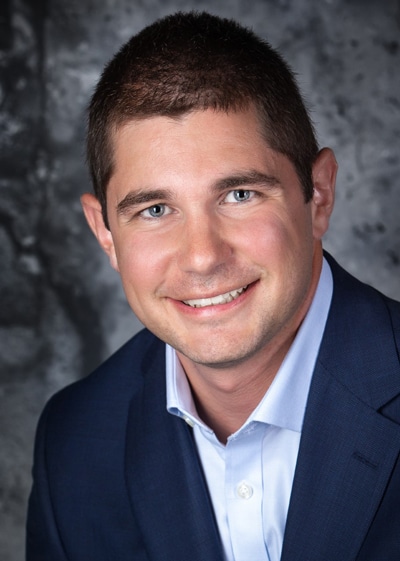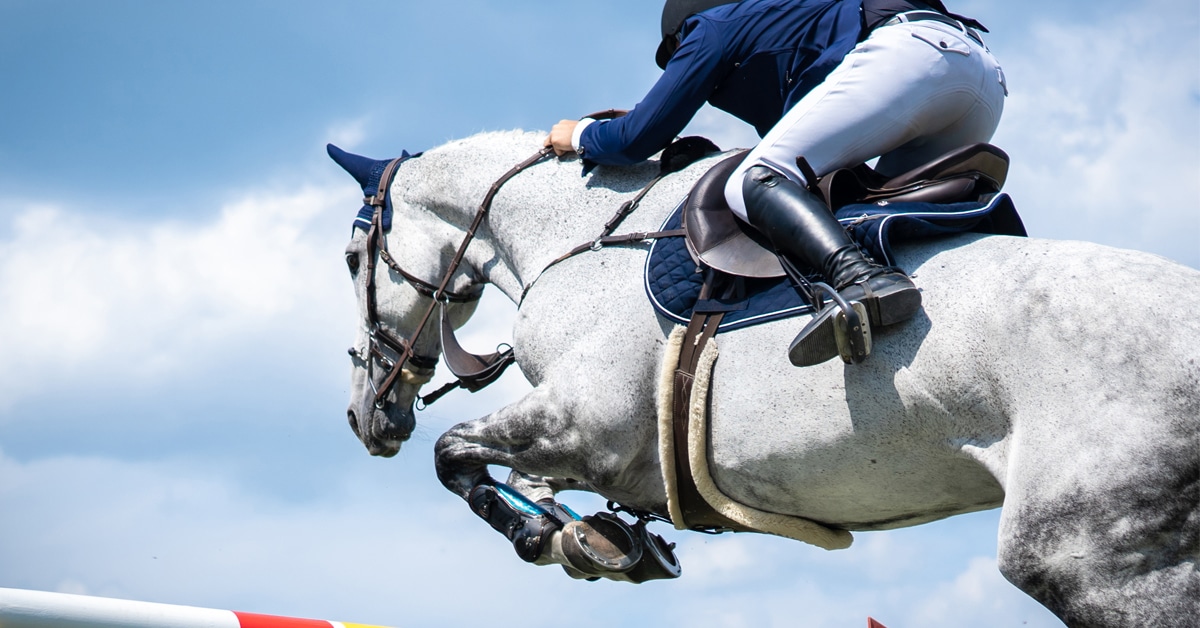Equestrian sports are steeped in tradition, which has meant that change comes slowly, but that doesn’t mean that there aren’t devoted riders, coaches, and other experts trying to improve and innovate.

Dr. Tim Worden
One of these experts is Dr. Tim Worden, PhD, whose ambition is to educate equestrians about biomechanics (the application of statistical analysis to biological data) and how different training modalities can affect performance, all with the goal of improving equine health and welfare. A rider as a youngster, Worden received a MSc in biomechanics and neuroscience and a PhD in biomechanics at the University of Guelph.
Now, he’s a member of the Equine High-Performance Sports Group and a sport performance consultant who specializes in the translation of human high-performance training concepts to equestrian athletes, with a focus on show jumping. He’s consulted for Equestrian Canada and been hired by several FEI riders to offer detailed performance analytics. He is also an author for online equestrian publications and has a podcast. If that wasn’t impressive enough, his “day job” is as Business Development Manager at Inteligex, a Toronto company developing cell-based therapies for humans who sustain spinal cord injuries.
HorseSport spoke with Worden about biomechanics and show jumping, his work with the high-performance sport group, and some tips and takeaways that riders across the spectrum can use to improve their riding and get the most out of their horses.
Horse Sport: What do you want equestrians to understand about the biomechanics of horses and the research you’ve done?
Tim Worden: The most important outcome that we are trying to optimize/train in equestrian sports is how the hoof interacts with the ground to generate forces. Everything in training needs to relate back to the hoof-surface interaction. Horses that can generate large horizontal velocities for hundreds of strides will excel as racehorses (typically Thoroughbreds), horses that can precisely place their feet to control their body (and that of the rider above them) will likely be successful in dressage, and horses that can place their hooves to position the body to generate high vertical impulse will be able to jump high.
So, what is most important when watching movement is to examine how the hooves contact the ground, and where the hooves are placed in relation to the body. This tells you a lot about the direction and magnitude of forces being generated by the horse. I don’t really care what the head and neck are doing (within reason) as long as the hooves are being placed down in the correct way. And to that point, riders need to be careful regarding their use of draw reins and certain bits, as they can negatively impact how the horse can generate force – even if they like how it alters the horse’s head carriage.
As a consultant, what are some of the main issues you find in individual training programs?
People should be thinking more about how their training programs are actually structured. A lot of riders tend to do the same training intensity every day, and the same duration, which just does not, in my opinion, make any sense. We know that for training to be successful, structures (muscle, tendon, bone, etc.) need to be stressed followed by a period that allows for recovery. We can get into more complex ways of structuring this to drive maximal adaptation, but in most circumstances the same work, whether that is jumping, the type of flatwork, etc., should not be done two days in a row in training. You need to be adjusting the intensity, duration, exercises, etc., to ensure the horse isn’t in an overly-repetitive program, which will lead to overtraining.
“Everyone puts the horse into workouts every day, and if it’s not jumping its flatting – but I don’t think many trainers are really considering the why behind this.”
With respect to how often horses are worked every week, people need to be paying more attention to this as well. If I write an exercise program, I tend to have horses doing something every day, but depending on the horse, 2-4 of these days will be focused on recovery. The rides and work aren’t meant to be very stressful; the goal is to foster recovery in the horse’s body and mind, allowing them to recharge. Then the other days are more intense, but there is always a reason for the workout. Does the horse need to work on strength? Speed? Endurance? Technique? The workouts need to be designed specifically to address these skills.
Conversely, I’ll throw Wellington under the bus as an example, because when you walk in one of those barns, everyone has a whiteboard. And you’ll see the horse’s names up there and everyone puts the horse into workouts every day, and if it’s not jumping its flatting – but I don’t think many trainers are really considering the why behind this. I think the world needs a bit more guidance surrounding that. Really top riders, they do bring that knowledge in. But I’d say for the most part, if you walk into the average barn, it’s a jumping school or it’s a flat session, it’s not thinking of the bigger picture: why are you doing that workout?
I think that we often forget what the goal of showjumping is. In an average class there are about 16 jumps on course, then in the jump-off there are probably eight jumps. So really, the training goal should be ‘how do we get the horse powerful enough, with enough balance, that it can do a jumping course and jump-off at speed’. And then how do we, for every other stride, which may be 50 to 70 strides in a jump off, how do we generate maximum horizontal velocity because that’s the end goal – to jump clear and fast in the jump-off. And I think if you look at those two metrics then a lot of what we do in training doesn’t contribute to that end goal. So, what’s the point? We are beating up a horse’s body in training and the output won’t actually make us more likely to win.
“If I was an athlete and you asked me to do the exact same workout six days in a row, I’d probably develop some major negativity in my mind, too.”
What is the solution?
I think it comes back to needing to be more diligent in training, and truly understanding what the athlete needs, and then how to stimulate the body in certain ways to get the outcome we want. There are so many ‘behavioral problems’, but so much of that is likely driven by putting the horse in a bad position.
If there’s a track and field coach who designs crappy programs, the athletes don’t want to be there. They lack motivation. They’re going to try to get out of training at every turn. If I was an athlete and you asked me to do the exact same workout six days in a row, I’d probably develop some major negativity in my mind, too.
I think that’s what we see in the horse world with the issues horses display (behavioral issues, gastric ulcers, and so on). It all circles back to how do you put the horses in the best position to perform their job and to be happy? If you have a horse and haven’t figured out how to make it happy and how to make it motivated, no matter what you do in training, you’re not going to get the result you want.
What other tip would you give trainers, riders, and amateur equestrians of any discipline?
People should be recording information about their workouts and program in a diary. Everyone should be recording what time of day they worked the horse, for how long, and the exercises they did. Also keeping track of farrier visits and vet appointments and treatments. When you record your training, and every aspect of your horse’s care, then you can go back and try to figure out the ‘why’ behind results and injuries. Go back and read it every few weeks to get a sense of the times when the horse performed really well and correlate this with the program. What were you doing in your program that the horse responded well too? And then when you go through those rough patches, with either injuries or poor performance, look for clues as to why this happened.
There are also technologies out there that can help to quantify and record important information. For example, Canadian FEI jumping rider Sean Jobin uses the Alogo Move Pro frequently in training and competition, and has been able to leverage this data to fine-tune his management approach for each horse.
Have you noticed any particular jumps that tend to be the most problematic for horses??
That’s a tough question to answer because there are a lot of factors at play and every horse/rider has individual strengths and weaknesses. With professional riders, combinations are more likely to cause rails than single jumps – this is likely because there is limited room to correct issues and to ‘hit’ key positions at take-off due to strength limitations. Skinny jumps are challenging because their narrow design gives less visual information to the horse and rider, so it can be harder to perceive the actual dimensions. In my own data looking at a few thousand rails, there did seem to be more rails off the left lead as compared to the right lead. Hypotheses for this include rider handedness or horse forelimb preference, strength imbalances in the horse and rider, visual dominance altering body positions, and so on.
“I’m a big fan of turnout, I think everyone should be looking for ways to get the horse out of the stall as much as possible.”
Are there any horse management issues you’ve noticed that need improving?
It comes down to things I think everyone appreciates are important but are often overlooked in the day-to-day program. For example, I’m a big fan of turnout, I think everyone should be looking for ways to get the horse out of the stall as much as possible. If you go to Wellington, you see horses spend most of their time in a stall, that there isn’t a lot of turnout. You see people spending a lot of time and money on things like therapies and treadmills, which is fine, and those tools have a place. But that’s maybe giving you a small improvement in recovery vs. get the horses outside and moving freely and you’re going to get a much more impactful benefit in recovery, which leads to improved performance and reduced likelihood of injury.

Worden (centre) spoke about injury prevention and strategies to improve performance at the United States Eventing Association meeting in 2019; pictured with (l-r) Dr. Susan Johns (US Eventing Team vet), Dr. Mark Revenaugh (past US Eventing Team vet), Stephen Teichman (past US Eventing Team farrier), and Max Corcoran (USEA president).
Tell us about the Equine High-Performance Sports Group – is it affiliated with the FEI or any national organization?
The group is not officially affiliated with any sport governing body, and that was done on purpose. Organizations in the horse world can be a little slow to adapt and to implement change, and that’s why the group was formed. Each of our founders has been involved at certain points in different federations and organizations, but it can be really hard to drive change in those groups. So, we decided to start something that was a little smaller, a little bit nimbler, and that we could really get behind to develop projects to address some of the gaps we have identified in equestrian sports.
What are some of the projects?
The Equine High-Performance Sports Group has a few different initiatives meant to tackle knowledge gaps in the industry. The first is our Sport Horse Series, which aims to bridge the gap between science and horsemanship by sharing cutting-edge research with the community. To do this, we have a podcast [the Sport Horse Podcast] that covers recent research and expert opinions on topics that every rider, trainer, veterinarian, and so on should be aware of. For example, we have had episodes discussing respiratory health, the use of water treadmills, detecting movement issues in horses, and so on.
We also have longer ‘lecture style’ talks on our website that go in-depth on topics followed by panel discussions with leading riders, veterinarians, and support staff. We have also held workshops to help translate knowledge to those who are designing and executing training programs in the field.
Our group also hosts Rehab Rounds once a month, which is an online discussion between clinicians on ideas regarding how best to manage a challenging case that is presented. It is a great place to share ideas and to discuss innovative approaches to manage complex cases. The Equine Regenerative Medicine and Orthobiologics Online Summit is held once a year and is focused on making the latest information on regenerative therapies available to veterinarians.
Lastly, we have launched an initiative to collect data on the outcomes of different therapies commonly utilized in sport horses. This will allow us to better understand what therapies work best for what conditions using big data approaches – stay tuned for more info on this exciting project!
With all the time you spend watching riders and horses, do you still ride?
I don’t ride anymore (I stopped in 2004). When I got back into the sport in 2010 (as a groom) I rode a bit and, of course, enjoyed it. But my strengths are for sure being on the ground and providing guidance in that way. Canada has a lot of really talented riders – they should be getting as much time in the saddle as possible, so I am perfectly fine helping from the ground and trying to support them the best that I can.

